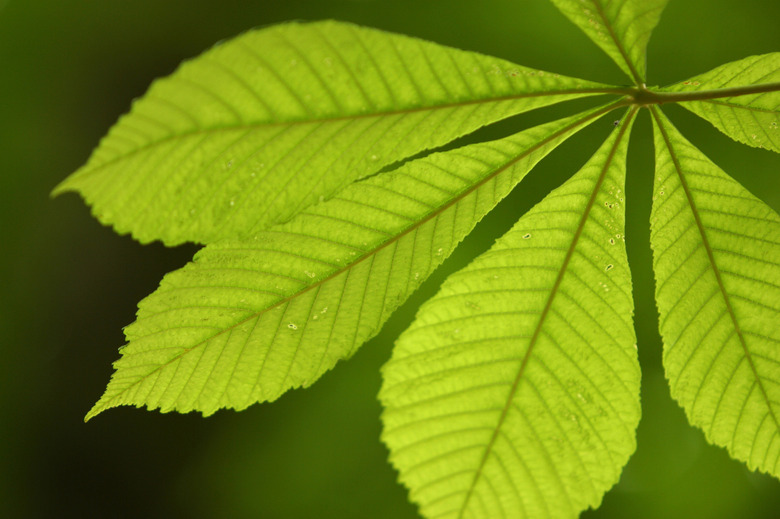What Does A Leaf Cell Do?
Plant leaves are the primary site of photosynthesis. Their flat surface maximizes the surface area exposed to sunlight. They also store food and water, and function in transportation – the loss of water vapor from the plant to the atmosphere.
Leaf cells, leaf structure, and leaf shape varies according to climate, the availability of light, humidity and temperature.
Leaf Structure – Leaf Tissues
Leaf Structure
– Leaf Tissues
A leaf cross-section reveals a cuticle layer and epidermal leaf cells on the underside and the top surface. Epidermal cells secrete a waxy substance known as the cuticle that aids in protection and keeps water from evaporating. Its epidermis gives the leaf structure, support and protection. The specialized stomata cells function as gate keepers, allowing carbon dioxide to enter and oxygen to escape. They are layered just above the epidermis on the bottom side of the leaves. Cells containing chloroplasts make up the central mesophyll layer. Some mesophyll cells contain as many as 50 chloroplasts.
Leaf Cells and Photosynthesis
Leaf Cells and Photosynthesis
Plants produce their own food through the chemical reactions of photosynthesis in the leaves. Chlorophyll, the green pigment, is located in cell organelles – chloroplasts – that reside in plant cells. The majority of a plant's chloroplasts are going to be found in the leaves since this is the primary place where photosynthesis occurs.
Photosynthesis has two phases: the light reaction and the dark reaction.
The daylight process converts solar energy to chemical energy and stores it as sugars. The requirements are light, carbon dioxide, and water. The reaction produces oxygen and sugar. The dark phase occurs at night and makes use of the energy produced during the day to convert carbon dioxide to sugar.
Stomata
Stomata
Pores called stomata on the underside of the leaf are formed by a pair of guard cells that regulate the size of the openings during gas exchange. Guard cells are usually open during the day and closed at night.
Air containing carbon dioxide and sometimes water enters through a stoma. Once the carbon dioxide and water are inside the leaf cells, the mesophyll cells use it to perform photosynthesis and respiration. Photosynthesis produces oxygen that exits the leaf through the stomata, and water vapor is released into the atmosphere through these pores in the transpiration cycle.
Stomata can also be used to regular water storage in leaf cells and plants in general. Leaving the stomata open could allow too much water to escape, which can lead to the plant drying out and dying. Keeping stomata closed at certain temperatures/in low moisture level can keep the plant properly hydrated.
Gas Exchange
Gas Exchange
Respiration is the major form of gas exchange in living organisms. On the cellular level, diffusion is the movement of molecules from a region of greater concentration to one with a smaller concentration of molecules until equilibrium is reached.
Plants respire when they absorb carbon dioxide and release oxygen through the stomata in the leaves. During transpiration, the leaves release water vapor in the same manner. The number of stomata present on the leaves varies according to temperature, humidity, and light intensity.
Types of Leaves
Types of Leaves
Not all leaves look the same, especially between gymnosperms and angiosperms. Gymnosperms are cone-bearing plants while angiosperms are flowering/fruiting plants.
Gymnosperms are known to have needle-like leaves like pine needles, for example. Angiosperms, on the other hand, have flat leaves that are veiny, like a maple leaf, for example.
Where they're similar is with all of the components we went over earlier. All leaves, no matter the shape or type, will help the plant perform photosynthesis, generate energy, and participate in gas exchange.
Cite This Article
MLA
Evans, Diane. "What Does A Leaf Cell Do?" sciencing.com, https://www.sciencing.com/leaf-cell-do-8715532/. 31 July 2019.
APA
Evans, Diane. (2019, July 31). What Does A Leaf Cell Do?. sciencing.com. Retrieved from https://www.sciencing.com/leaf-cell-do-8715532/
Chicago
Evans, Diane. What Does A Leaf Cell Do? last modified March 24, 2022. https://www.sciencing.com/leaf-cell-do-8715532/
